
The Sienese School of painting flourished in Siena, Italy, between the 13th and 15th centuries. Its most important artists include Duccio, whose work shows Byzantine influence, his pupil Simone Martini, the brothers Pietro and Ambrogio Lorenzetti and Domenico and Taddeo di Bartolo, Sassetta, and Matteo di Giovanni.
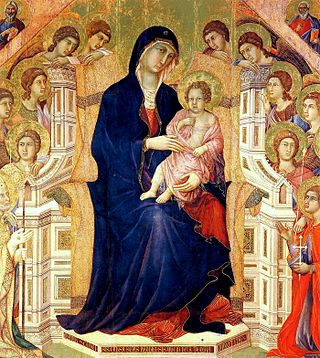
Duccio di Buoninsegna, commonly known as just Duccio, was an Italian painter active in Siena, Tuscany, in the late 13th and early 14th century. He was hired throughout his life to complete many important works in government and religious buildings around Italy. Duccio is considered one of the greatest Italian painters of the Middle Ages, and is credited with creating the painting styles of Trecento and the Sienese school. He also contributed significantly to the Sienese Gothic style.

Simone Martini was an Italian painter born in Siena. He was a major figure in the development of early Italian painting and greatly influenced the development of the International Gothic style.
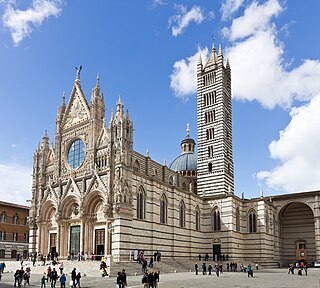
Siena Cathedral is a medieval church in Siena, Italy, dedicated from its earliest days as a Roman Catholic Marian church, and now dedicated to the Assumption of Mary.

The Collegiata di Santa Maria Assunta or Duomo di San Gimignano is a Roman Catholic collegiate church and minor basilica in San Gimignano, in Tuscany in central Italy. It contains important cycles of Renaissance frescoes by artists including Domenico Ghirlandaio, Benozzo Gozzoli, Taddeo di Bartolo, Lippo Memmi and Bartolo di Fredi. It falls within the UNESCO World Heritage Site of the "Historic Centre of San Gimignano", with its frescoes being described by UNESCO as "works of outstanding beauty".
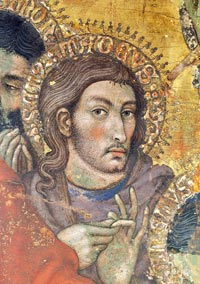
Taddeo di Bartolo, also known as Taddeo Bartoli, was an Italian painter of the Sienese School during the early Renaissance. His biography appears in the Vite of Giorgio Vasari, who claims that Taddeo was the uncle of Domenico di Bartolo.
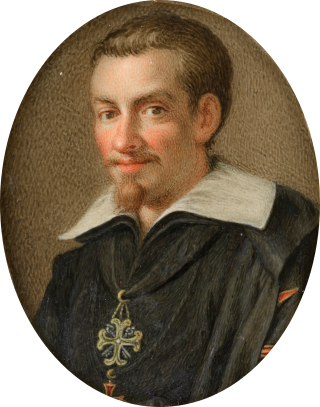
Francesco Vanni was an Italian painter, draughtsman, printmaker, publisher and printer active in Rome and his native city of Siena.
Sano di Pietro or Ansano di Pietro di Mencio (1405–1481) was an Italian painter of the Sienese school of painting. He was active for about half a century during the Quattrocento period, and his contemporaries included Giovanni di Paolo and Sassetta.

Bartolo di Fredi, also called Bartolo Battiloro, was an Italian painter, born in Siena, classified as a member of the Sienese School.
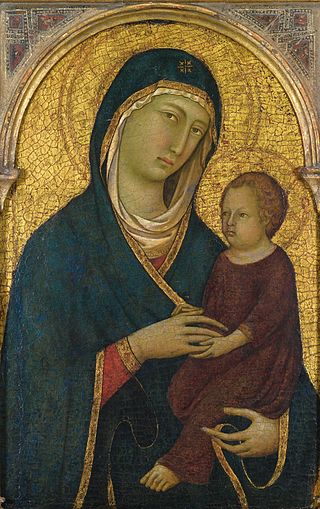
Segna di Bonaventura, also known as Segna de Bonaventura, and as Segna di Buonaventura, was an Italian painter of the Sienese School. He was active from about 1298 to 1331.

Lippo Memmi was an Italian painter from Siena. He was the foremost follower of Simone Martini, who was his brother-in-law.
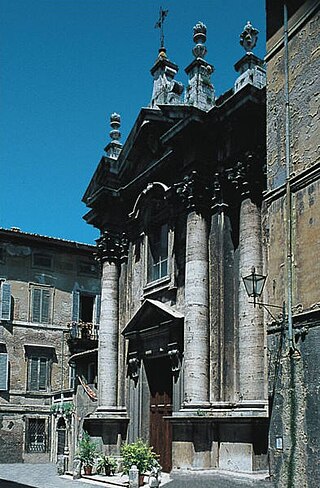
San Giorgio is a Baroque style, Roman Catholic church located on Via di Pantaneto #113 in the Terzo San Martino of the city of Siena, region of Tuscany, Italy.

The Basilica of San Domenico, also known as Basilica Cateriniana, is a basilica church in Siena, Tuscany, Italy, one of the most important in the city. The basilica is an example of Cistercian Gothic style.
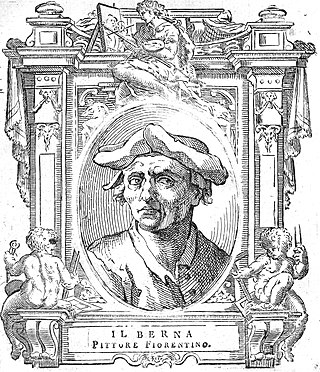
Barna da Siena, also known as Berna di Siena, was presumed to be a Sienese painter active from about 1330 to 1350.

Niccolò di Ser Sozzo was an Italian painter and manuscript illuminator. He generally has been identified as Niccolò di Ser Sozzo di Francesco Tegliacci, but recent research points instead to a Niccolò di Ser Sozzo di Stefano. Whatever his true identity, Niccolo was one of the leading panel painters and miniaturists at work in Siena in the mid-14th century. His style is closest to that of Lippo Vanni and his sometime collaborator Luca di Tomme and is ultimately dependent upon the tradition of Simone Martini and, especially, the Lorenzetti brothers, in whose workshop he may have apprenticed.

Jacopo di Mino del Pellicciaio was an Italian painter, active in Siena.

Naddo Ceccarelli was a 14th-century Italian painter of the Sienese School.

The Palazzo Comunale, also known as the Palazzo del Popolo of San Gimignano has been the seat of the civic authority in the comune since the 13th century. It is located on the Piazza del Duomo close to the Collegiate Church of the Assumption of the Blessed Virgin Mary. The building and Collegiate Church are at the heart of the medieval town, and are part of the UNESCO World Heritage Site of the "Historic Centre of San Gimignano".

Bartolomeo Bulgarini, also known as Bulgarino or Bologhini, was an Italian painter of the Trecento period in Siena both before and after the Black Death.

Guidoriccio da Fogliano at the Siege of Montemassi is a fresco on the western wall of the Sala del Mappamondo in the Palazzo Pubblico in Siena. It shows Guidoriccio da Fogliano, the commander of the Sienese troops, on horseback against the background of a landscape in which the siege of Montemassi takes place..



















